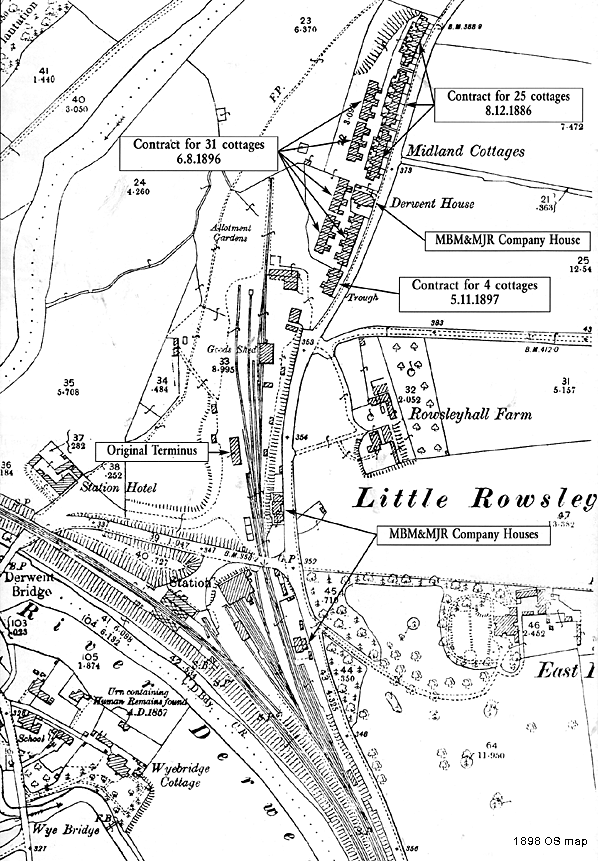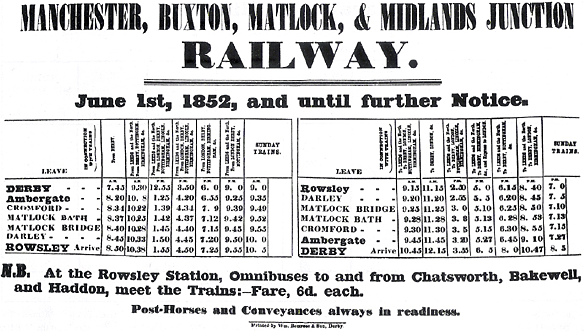
Station Name: ROWSLEY 1st SITE
|
| Date opened: | 4.6.1849 |
| Location: | North side of the A6 in the middle of the Peak Village shopping complex. |
| Company on opening: | Manchester, Buxton, Matlock and Midland Junction Railway |
| Date closed to passengers: | 1.8.1862 |
| Date closed completely: | 1.7.1968 (some wagons were not removed till the following week) |
| Company on closing: | Midland Railway |
| Present state: | Extant. In use as retail outlets in the centre of the Peak Village shopping complex. |
| County: | Derbyshire |
| OS Grid Ref: | SK258661 |
| Date of visit: | 2.10.2009 |
Notes: Notes: Rowsley’s first station was situated at the northern end of the Manchester, Buxton, Matlock and Midland Junction Railway’s (MBM&MJR) line from Ambergate to Rowsley which opened to passengers on Monday the 4th June 1849. The MBM&MJR was formed in 1845 with the single purpose of creating a line from Ambergate to Stockport. The company was backed by the Manchester and Birmingham railway in the north and the Midland Railway (MR) who had their headquarters in Derby. These two companies wanted to create a route between Manchester and London which would not rely on the use of other companies railways. On the very day that the MBM&MJR was incorporated the London and Birmingham Railway became part of the London North Western Railway (LNWR). The LNWR had a route to London from Manchester and so it had no interest whatsoever in a line that connected into the Midland Railway network. At about the same time the Duke of Rutland made it clear that he would not want any new railway crossing his land. The projected route was to run through his estate at Haddon. The MBM&MJR had to rethink and the result of this was to determine where Rowsley’s first station was to be sited.
Rowsley Station was designed by Joseph Paxton (who also designed the Crystal Palace in London). It was provided with a single storey stone built building which had arched windows and doors. The roof projected out from the building to form a canopy. The station was provided with one low platform on its east side. The station was located on the north side of what is now the A6 in a position that would have allowed the line to continue on towards Chatsworth. Goods facilities were provided which included a goods shed. At the time of opening six trains arrived and left Rowsley on weekdays and two on Sundays. A horse drawn omnibus service gave connections to Chatsworth and to Bakewell. Horse drawn coaches also provided onward connections to Buxton. Trains were operated from the start by the MR.
In 1851 a house was built for the station master, four cottages for employees and a house for the company secretary which also acted as a company office. [Only two Station Masters are believed to have lived in the original SM’s house – from 1853 to 1856, and from 1875 to 1890. The first and third SMs (1849 to end of 1852, and 1856 to 1875) were single, and it was not company policy to rent railway property to single men. The Goods Agent (a separate post from 1885 to 1902) occupied the house from 1890 to 1902; thereafter, District Inspectors and later Yard Masters lived there. From 1898 to 1963, the SMs lived in Derwent House, the one built for the MBM&MJR Company Secretary, later No.18 Midland Cottages. This became derelict and was demolished in the 1970s – the only railway house in the Rowsley area that no longer exists.]
Initially Rowsley had a single road stone built engine shed with a turntable at the entrance which opened with the line in 1849. The shed was closed by the Midland Railway in 1879/80 and it was rebuilt as a stone built 4 track straight dead-ended shed with a triple gable style pitched slate roof. The new shed made use of the engine pit of the previous shed under one of the gables. The other two gables unusually covered 1 and then 2 roads to the west. It is believed that the western twin track shed was originally intended as a carriage shed. The facilities were improved by re-siting the turntable and the building of a ramped coal stage. A boiler house and sand furnace were contained within the shed. In 1882, a new turntable was built in the yard to the south and in 1887, a well was sunk and a water tank provided. On 28th June 1926, the shed was closed and replaced by a new shed located about a mile to the south. During the late 1850s proposals were made by independent groups that would have seen a line built between Rowsley and Buxton. This caused the MR a great deal of concern and so they resurrected the original plan of the MBM&MJR to take the line to Buxton via Haddon. This time the Duke of Rutland did not object as the citizens of Bakewell, who would be served by a line following this route, had lobbied him to remove his objections. In 1860 the MR received an act for the building of a line and work began. Because Rowsley Station had been built on an alignment that would have seen the line extended towards Chatsworth it was not suitable as a station for the new line which would have to diverge from the original line south of the A6. A new station had to be provided. The new line to Buxton opened to passengers as far as Hassop on the 1st August 1862. A new Rowsley station opened on the same day and Rowsley's first station closed to passengers.
Timetable from Rowsley Association
This was not the end for Rowsley’s first station, as it continued to be an important goods depot. In 1877 extensive marshalling sidings (known as Rowsley Sidings) opened east of and below the A6 and from that point on Rowsley first station was known as 'The Old Yard'. In 1905 a narrow gauge railway was opened from the Old Yard to Chatsworth Park. It was used in connection with the construction of an aqueduct for the Derwent Valley Waterboard. The line was in use for just over a year. George Bell, the contractor, commenced laying the line from Rowsley northwards on 12th July 1905 and reached the southern boundary of the Park by 24th August. However, he did not receive permission to lay his railway through the Park until January 1906, on the condition that all excavation work be completed and the line removed and turf relayed within 6 months. It is recorded that Bell finished his work on 24th July 1906. In 1919 the Canadian Forestry Corps built sidings at The Old Yard to serve sawmills which dealt with hardwood cut from local forests. Another narrow gauge line was constructed to assist with this activity. The Old Yard handled not only timber but also stone from local quarries and agricultural produce. It also handled milk. In 1933 the Express Dairy opened a processing plant adjacent to the new Rowsley station in order to take advantage of the rail facilities at Rowsley.
It was originally proposed that Bakewell and Rowsley goods depots should remain open, but the need to man Rowsley North Junction, Church Lane Crossing and Darley Dale station signalboxes subsequently led to the decision to close them should the Minister of Transport agree to the diversion of the expresses. Consent to the diversion of the expresses was given on 22nd April 1968; an announcement on the closure of the two goods depots was made on 17th May. Fortunately the Grade II listed (from 26th October 1972) station building survived after closure while all the buildings around it were demolished. It is fortunate that it had found alternative use by one of the private firms with premises in the Old Yard, otherwise it could well have been demolished. In the 1990s plans for a shopping complex included the station as a centerpiece. In April 1999 the Peak Village Shopping Outlet opened with a fully restored Rowsley Old Station being one of its main features, it is now occupied by Fosters Retail Gallery. Other web sites: Peak Rail now providing a regular steam service between Matlock and Rowsley. David Hey's Collection - Transition from BR steam. Includes railway photographer ER Morten's photographic tour from Buxton - Derby. The Rowsley Association run by ex-railwaymen and their families from the area. Eight and a half miles of the Matlock - Buxton line now forms the Monsal Trail starting at Coombs Road Viaduct, one mile southeast of Bakewell and finishing at the head of Chee Dale, about three miles east of Buxton. There is a diversion round the tunnels. EXPLANATION OF TICKETS: Ticket number 2914 is the return half of a ticket issued at Matlock Bath on 20th August 1861. As was the practice until the late 1860s, it is untitled. It was printed by the Midland Railway, but as the owning company was still the MBM&MJR (albeit leased), it can properly be described as a ticket from that company. Further reading: Railway from Buxton to Bakewell, Matlock and Ambergate (Scenes from the Past) by JM Bentley, 1992. Railways around Buxton by JM Bentley, 1987. Rowsley : A Rural Railway Centre by Glynn Waite and Laurence Knighton, (Midland Railway Society), 2003 ISBN 0-9537486-2-6. Rowsley Railway Miscellany, edited by Glynn Waite (Rowsley Association), 2006 ISBN 978-0-9552251-1-6. Rowsley Railway Miscellany – 2, edited by Glynn Waite (Rowsley Association), 2008. ISBN 978-0-9552251-9-2. Rowsley’s Engine Sheds by Glynn Waite (Rowsley Association), 2007. The last four listed above are available from the Rowsley Association. Additional notes and photo captions by Glynn Waite/Rowsley Association. Click here for a more detailed history of the complete closure process of the Derby - Buxton/Manchester line. Click here to see a series of pictures of the A6 bridge at the north end of Rowsley station being replaced in 1965. To see other stations between Manchester Central & Matlock click on the station name:Manchester Central, Chorlton-cum-Hardy, Withington & West Didsbury, Didsbury, Heaton Mersey, Cheadle Heath, Hazel Grove (Midland), Buxworth, Chinley (2nd site) STILLOPEN, Chinley (1st site), Chapel-en-le-Frith Central, Peak Forest, Cheedale Halt, Buxton (Midland), Blackwell Mill Halt, Millers Dale, Monsal Dale, Great Longstone, Hassop, Bakewell, Rowsley (2nd site), Rowsley South PEAK RAIL, Darley Dale, Matlock Riverside PEAK RAIL & Matlock STILL OPEN. See also Stockport Tiviot Dale & Stockport Portwood |
first_old7.jpg)
Photo from Rowsley Old Station and Goods Yard

Simulated OS map showing the position of Rowsley's first station
 This 1898 OS map shows the first station and the 2nd station which was opened in 1862.
This 1898 OS map shows the first station and the 2nd station which was opened in 1862.Received from Rowsley Association
first_old15.jpg)
Photo from Rowsley Association
first_old3.jpg)
Copyright photo from John Alsop collection
old6.jpg)
Photo from Rowsley Old Station and Goods Yard
first1.jpg)
Photo by Nick Catford
first3.jpg)
Photo by Paul Wright
| Last updated: Monday, 22-May-2017 13:04:46 CEST |
© 1998-2010 Disused Stations
|





first13.jpg)

 Home Page
Home Page